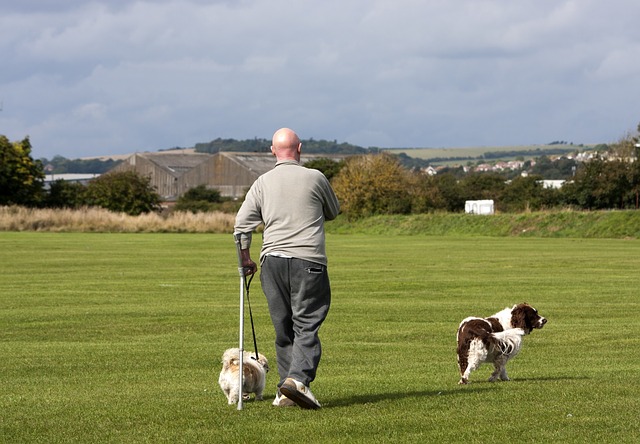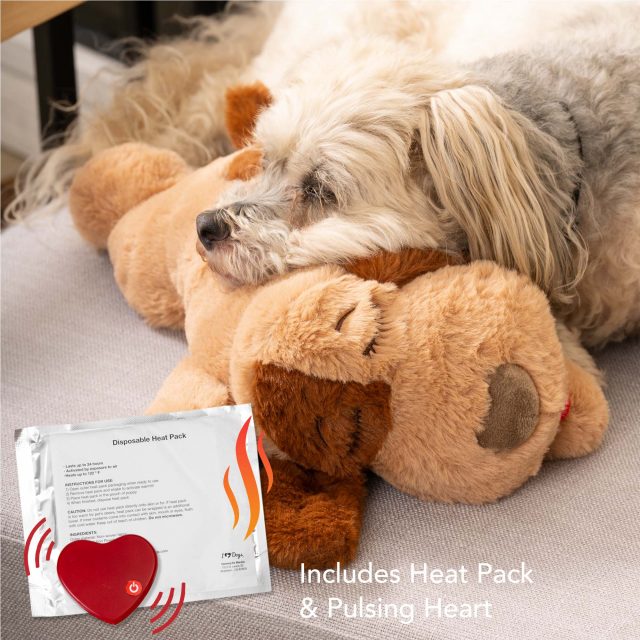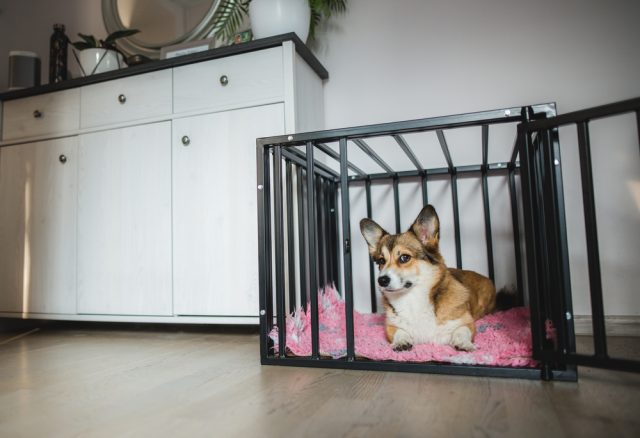You come home from work thrilled to be greeted by your four-legged best friend, but it’s soon obvious you weren’t the only one who had a rough day. Stinky accidents, chewed up belongings, destroyed furniture, another noise complaint from the neighbor—they’re all signs your dog gets stressed when home alone.
Whether it’s extreme separation anxiety or a general loathing of being left alone, not being able to safely stay home alone is a problem. You hate the clean-up, but your pup is suffering from extreme stress. Staying home 24/7 isn’t an option, so here are a few ideas to help your pup feel more comfortable and confident at home alone.
1. Create a Safe Space
There should be an area in your home where your dog feels the most safe and secure. For most pets, their favorite areas are small, comfy, and isolated. It’s where they go to escape the chaos of the outside world, and it can be used to help them feel calm in moments of stress. Trainer Tony Cruse says,
“Even if you think your dog is bomb proof and not in the least bit nervous, there will be times when he will need a place to escape, a sanctuary. Create a safe haven and make everyone aware of it.”
Most dog owners do this through crate training. The crate is never used as punishment, and instead, it’s a beacon of all things safe and good. If you don’t want to crate train, a small room or blocked-off area of the house will also work. If your dog isn’t confident enough to be left alone with unrestricted access to the entire house, keep them confined in their safe place while you’re gone.
Related: The 9 Best Dog Crates
2. Exercise Before You Leave
One of the most common reasons why dogs destroy things while their owners are gone has to do with pent up energy. Being home alone means there are no people to observe or play with, and for a dog that loves to be social, that’s a distressing situation. You can help ease the throes of boredom by appropriately exercising your dog before you leave the house.
If you have to leave them alone while you go to work, wake up a half hour early to take pup for a walk. The physical activity will give your dog a chance to burn energy so they’ll be better able to relax when the house gets quiet and boring.
Related: Best Durable Balls For Vigorous Games Of Fetch

3. Keep Calm
Dogs are perceptive family members, and if you’re worked up about something, they will be too. They can tell when you’re stressed or worried, and knowing their leader—the person who is supposed to be their rock—is breaking down will be all the more concerning. When you go to leave the house, make sure you’re both calm.
Drawn-out goodbyes make you feel better, but it actually makes your dog feel worse about the prospect of being home alone. Instead of telling them how much you love them and that you’ll be back soon, walk out the door without talking to or touching them. Start ignoring them several minutes before you leave, and simply leave like it’s business as usual. This will show your dog that you’re not worried, and they shouldn’t be either.
4. Start Short
Like every other lesson your dog learns, you can’t expect them to be an expert at staying home alone on their first try. It takes practice, and it’s best to start small. When you bring a new dog home, start the process by leaving them home alone for only five minutes at a time. Walk out the door as if you’re going to work and do a loop around the block. If they successfully pass that test, you can increase the time. If you want to avoid messy accidents, remember younger dogs shouldn’t be left alone as long as mature adults.
In general, puppies can hold it for one hour per every month of age. So a three month old puppy can only go three hours before they need a potty break.

5. Provide Comforting Entertainment
There are several things you can leave out for your dog to provide both comfort and entertainment while you’re gone. An old t-shirt that smells like you will be comforting and make it seem like your close by even when you’re far away. There’s even a toy from Project Play that’s designed for this exact purpose. You can buy it here.
You can also leave your dog with treat toys that keep them too busy to be stressed. Strong rubber treat-dispensing toys are safe to give your dog while unsupervised, and they could spend hours licking every trace of peanut butter from the inside. If you want to leave other chew toys or interactive puzzles out for your dog, first make sure they’re 100% safe.
If appealing to their senses of smell and taste doesn’t work, many dog owners use soothing sounds to keep stressed-out pups calm. Try leaving the TV or radio on to make pupper feel like he’s not all alone. There are even audiobooks and soothing sound machines that are specifically made to help keep dogs calm while home alone.
The adorable toy below mimics a comforting heartbeat sound.

6. Resist the Urge to Punish
When you come home to find your favorite shoes destroyed, a pile of poo on your new carpet, and an annoyed message saying your dog howled all day long, your first instinct is to yell and punish the dog. It’s a natural response, but it also makes the situation worse.
Dogs aren’t like humans. They can’t connect past behaviors with present punishments. So if you punish them for chewing on something and wave the incriminating evidence in their face, they’ll have no idea what you’re doing. All they’ll know is you’re mad and they’re in trouble. Unpredictable punishments will make them feel even more scared and insecure, which in turn will lead to more stress and behavioral problems when they’re left alone. It’s a vicious cycle that only you can break. Use positive reinforcement on days you come home to a clean house, but never use punishment on the bad days.
7. Leave Your Scent with Them!
As most of us know, dogs perceive the world primarily through scent. This innovative dog toy makes an easy and cute way for your to leave your scent with your pup. Watch the video below to see how it works.

 Toledo, United States.
Toledo, United States.